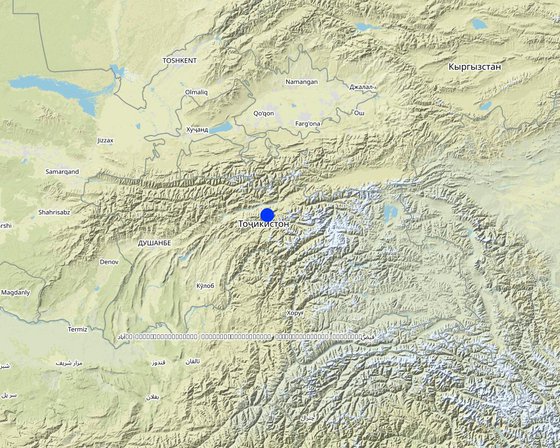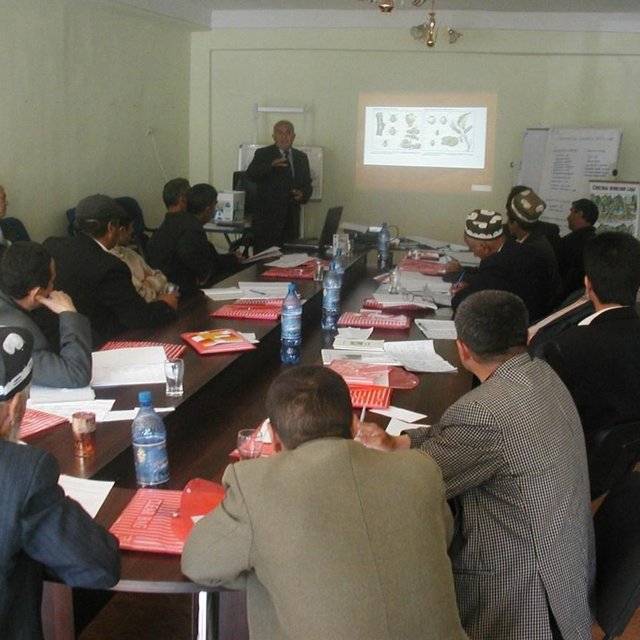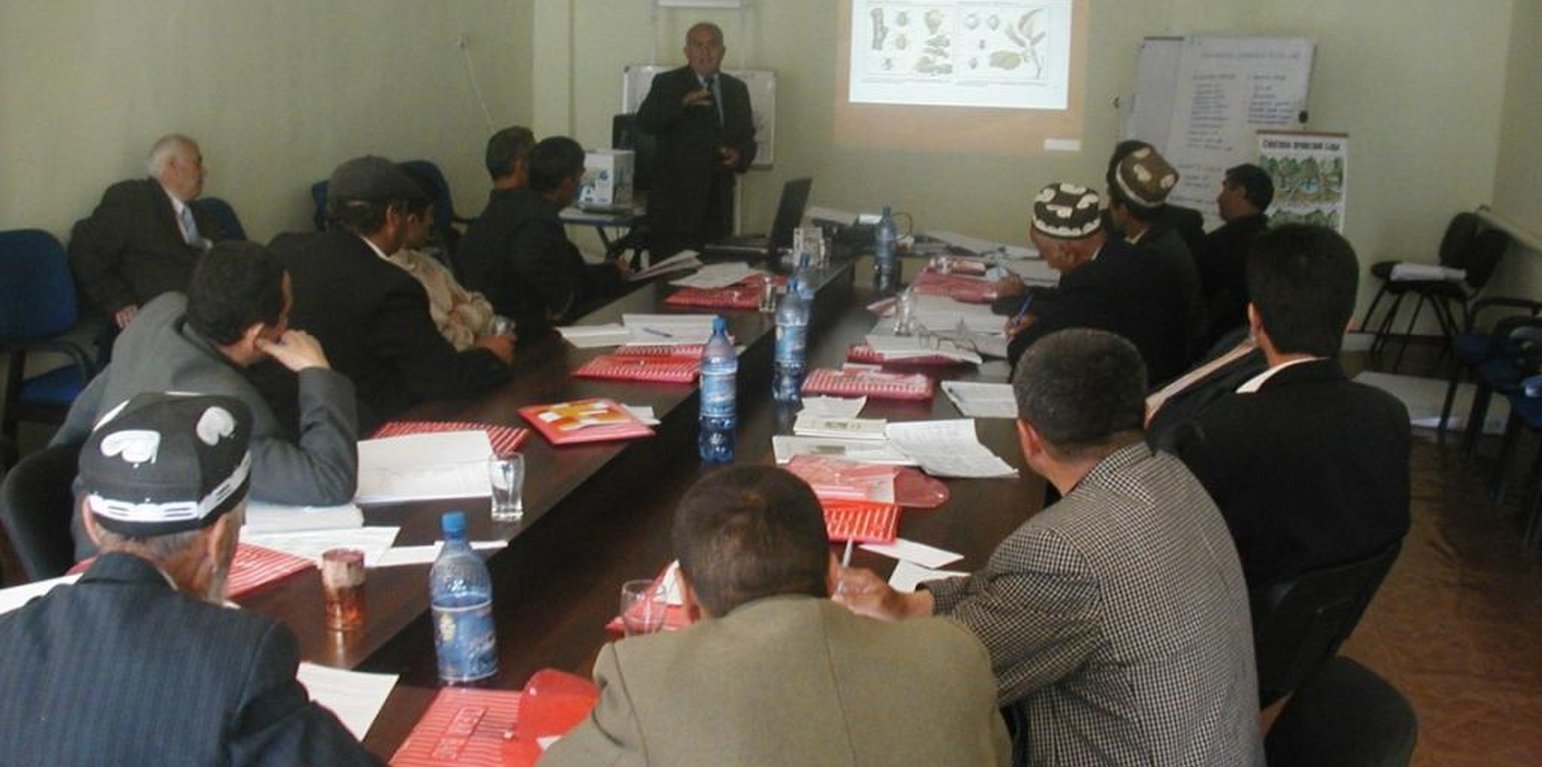Facilitation of community-based pasture management initiatives
(Tajiquistão)
Mountain Societies Development Support Programme - Aga Khan Foundation
Descrição
Initiation of community-based solutions to slow down pasture degradation, and to improve pasture use and management in three pilot Jamoats of upland Tajikistan.
Aims / objectives: During the Soviet times land users in Tajikistan were allowed to keep very little livestock individually and this was mainly in the vicinity of rural settlements. The majority of the livestock were managed by collective agricultural farms, which utilised different seasonal pastures. After the collapse of the Soviet Union, the previously state-owned livestock was distributed among individual farmers, most of whom had limited knowledge and experience with pasture management (PM), and capacities to access the distant pastures used by the collective farms. As a consequence, the amount of livestock kept in the vicinity of rural settlements increased, leading to overgrazing and severe degradation of nearby pastures. In the framework of a project on sustainable land management in the Pamir-Alai region (PALM), funded by the Global Environment Facility (GEF), MSDSP facilitated the initiation of community-based solutions to the problem of pasture degradation at three pilot jamoats in Jirgital, and three in Gorno-Badakhshan Autonomous Oblast (GBAO).
Methods: 1. Awareness raising and capacity building of PM issues. 2. Integration of PM issues in village development plans. 3. Grant support and community co-financing for implementation of targeted measures. 4. Monitoring of the impacts of the implemented measures as a basis for up-scaling.
Stages of implementation: 1. National pasture management experts from the Pamir Biological Institute held a training of trainers (ToT) session for MSDSP facilitators and district specialists, who conducted follow-up training on PM at the pilot communities in 2009. 2. Pilot communities identified key problems related to PM in the process of Village Development Planning facilitated by MSDSP, and prioritised targeted measures for improved PM. 3. A set of micro-project proposals were developed based on the prioritised measures, which focused on (re-) construction of roads and bridges for improved access to pastures, and construction of stables during spring/autumn, as well as summer pastures. 4. Monitoring of the impacts of the implemented measures as a basis for up-scaling.
Role of stakeholders: Community members were engaged in identifying and implementing targeted measures for addressing pasture use and management issues. Jamoat level non-governmental organisations called Social Unions for Development of Village Organizations (SUDVOs), coordinated and supported the identification and implementation of the selected projects in several village organisations. Governmental agricultural extension agents were engaged in training, and consulted in the review process. MSDSP staff facilitated the overall process and engaged in monitoring progress with implementation. PALM project staff engaged in the review, monitoring and assessment of the impacts of the supported measures.
Localização

Localização: Jirgatol, Tajiquistão
Geo-referência de locais selecionados
Data de início: 2009
Ano de término: n.a.
Tipo de abordagem
-
Tradicional/Indígena
-
Iniciativa/inovação local recente
-
Baseado em projeto/programa

Training of Trainers through expert (MSDSP Khorog)
Objetivos de aproximação e ambiente propício
Principais metas / objetivos da abordagem
The Approach focused mainly on SLM with other activities (rehabilitation of rural infrastructure to improve access to pastures, pasture and livestock productivity, animal diseases)
The main aim of the approach was to initiate the improved use and management of pastures, by raising awareness and knowledge on issues regarding pasture degradation and sustainable pasture management, mobilising community action, and pilot-testing selected technologies and measures for improving pasture management in highly degraded areas.
The SLM Approach addressed the following problems: pasture degradation, overgrazing, restricted pasture area and too many cattle garzing, lack of infrastructure (bridges, roads, shelters), lack of knowledge about pasture management
Condições que permitem a implementação da Tecnologia(s) aplicada(s) sob a Abordagem
Condições que dificultam a implementação da Tecnologia(s) aplicada(s) sob a Abordagem
-
Disponibilidade/acesso a recursos e serviços financeiros: communities were lacking funds for infrastructure development and could therefore not invest in the construction of roads and bridges
Treatment through the SLM Approach: GEF funds were used to support communities in financing infrastructural improvements which allowed for more productive and sustainable use of available pasture resources
-
Quadro institucional: Lack of capacity to deal with pasture degradation problems
Treatment through the SLM Approach: Engagement of village organisations, and social unions of village organisations (SUDVO) in addressing pasture management issues at six pilot jamoats
-
Quadro jurídico (posse de terra, direitos de uso da terra e da água): Limited clarity regarding responsibilities and lack of incentives for sustainable pasture management
Treatment through the SLM Approach: MSDSP and PALM project members recommended the development of a pasture management law that addresses those legal constrains
The existing land ownership, land use rights / water rights moderately hindered the approach implementation there is no law about pasture management in Tajikistan, therefore it was difficult to regulate the process
-
Conhecimento sobre GST, acesso a suporte técnico: technical knowledge about pasture management was lacking as during Soviet times people were not allowed to keep a lot of livestock
Treatment through the SLM Approach: Community members of village organisations and relevant government experts were trained in various issues of pasture management
Participação e papel das partes interessadas envolvidas
Partes interessadas envolvidas na abordagem e seus papéis
| Que partes interessadas/órgãos de implementação estavam envolvidos na abordagem? |
Especifique as partes interessadas |
Descreva o papel das partes interessadas |
| Usuários de terra/comunidades locais |
Village organisations
Only 20% of the participants were women, since men are responsible for managing the livestock, while women are concerned with livestock products only
Elderly members of the communities were engaged in discussions on the possible solutions |
|
| Especialistas em GST/ consultor agrícola |
Governmental agricultural advisors participated in the training. |
|
| Governo nacional (planejadores, responsáveis pelas decisões) |
Agrarian University in Jirgatol, Pamir Biological Institute |
|
| pilot communities |
|
|
Envolvimento do usuários de terra/comunidades locais nas diferentes fases da abordagem
Nenhum
Passivo
Apoio externo
Participativo
Automobilização
Planejamento
Members of village organisations were involved in training and planning on pasture management, and actively participated in discussions
Implementação
The village organisations developed their own project ideas and submitted those proposals to MSDSP and other funders
Monitoramento/avaliação
Land users were engaged in the monitoring and evaluation of the impacts of the implemented projects
Research
The Pamir-Biological Institute and the Institute of Botany under the Academy of Sciences were engaged in research and technical consultations
Tomada de decisão sobre a seleção da Tecnologia GST
As decisões foram tomadas por
-
Somente usuários da terra (iniciativa própria)
-
Principalmente usuários da terra, apoiados por especialistas em GST
-
todos os atores relevantes, como parte de uma abordagem participativa
-
Principalmente especialistas em GST, após consulta com usuários da terra
-
Somente especialistas em GST
-
Políticos/líderes
-
pilot communities
As decisões foram tomadas com base em
-
Avaliação de conhecimento bem documentado de GST (tomada de decisão baseada em evidências)
-
Resultados de pesquisa
-
Experiência pessoal e opiniões (não documentado)
Suporte técnico, reforço das capacidades e gestão do conhecimento
As seguintes atividades ou serviços têm sido parte da abordagem
-
Reforço das capacidades/ formação
-
Serviço de consultoria
-
Fortalecimento da instituição (desenvolvimento organizacional)
-
Monitoramento e avaliação
-
Pesquisa
Reforço das capacidades/formação
Foi fornecido treinamento às seguintes partes interessadas
-
Usuários de terra
-
Equipe de campo/consultores
Tipo de formação
-
Em exercício
-
Agricultor para agricultor
-
Áreas de demonstração
-
Reuniões públicas
-
Cursos
Assuntos abordados
Short training courses were provided for land user, field staff/agricultural advisors
Serviço de consultoria
Foi prestado um serviço de consultoria
-
nas áreas dos usuários da terra
-
Em centros permanentes
-
through trained experts
Name of method used for advisory service: Engineering support and technical consultations
Advisory service is quite adequate to ensure the continuation of land conservation activities
Fortalecimento institucional
As instituições foram fortalecidas / estabelecidas
-
Não
-
Sim, pouco
-
Sim, moderadamente
-
Sim, significativamente
Descreva instituição, papéis e responsabilidades, membros, etc.
Tipo de apoio
-
Financeiro
-
Reforço das capacidades/ formação
-
Equipamento
Mais detalhes
village organisations were trained
Monitoramento e avaliação
economic / production aspects were regular monitored by project staff through observations; indicators: changes in economic benefits for households before and after implementation of project
bio-physical aspects were regular monitored by project staff through observations; indicators: changes in vegetation coverage, edible grass species, etc.
area treated aspects were regular monitored by project staff through observations; indicators: Established at the start of project implementation
There were several changes in the Approach as a result of monitoring and evaluation: Some areas were grazed although they should not have been, project staff then talked to the responsible people in the village to ask about the causes for this and to try and initiate changes in practice.
Pesquisa
As pesquisas trataram dos seguintes tópicos
-
Sociologia
-
Economia/Marketing
-
Ecologia
-
Tecnologia
-
pasture management
Aimed at problem, option and impact assessment
Research was carried out on-farm
Financiamento e apoio material externo
Orçamento anual em USD para o componente GST
-
< 2.000
-
2.000-10.000
-
10.000-100.000
-
100.000-1.000.000
-
> 1.000.000
Precise annual budget: n.a.
Approach costs were met by the following donors: international (PALM): 70.0%; national non-government (MSDSP): 30.0%
Os seguintes serviços ou incentivos foram fornecidos aos usuários de terras
-
Apoio financeiro/material concedido aos usuários da terra
-
Subsídios para insumos específicos
-
Crédito
-
Outros incentivos ou instrumentos
Parcialmente financiado
Totalmente financiado
A mão-de-obra dos usuários da terra foi
-
Voluntário
-
Comida por trabalho
-
Pago em dinheiro
-
Recompensado com outras formas de apoio material
Análise de impactos e declarações finais
Impactos da abordagem
Não
Sim, pouco
Sim, moderadamente
Sim, significativamente
A abordagem auxiliou os usuários da terra a implementar e manter as tecnologias de GST?
Reduced pressures on pastures in the vicinity of rural settlements
A abordagem concedeu autonomia aos grupos social e economicamente desfavorecidos?
Elderly herders with improved access to health facilities
A abordagem melhorou as questões de posse de terra/diretos do usuário que inibiam a implementação das tecnologias de GST?
talks with the government were started to make way for a law on pasture management
Did other land users / projects adopt the Approach?
Strong interest by other communities but limited financial means for replication
Principal motivação dos usuários da terra para implementar a GST
-
Produção aumentada
-
Lucro (lucrabilidade) aumentado, melhora da relação custo-benefício
-
Degradação do solo reduzida
-
Riscos de desastre reduzido
-
Carga de trabalho reduzida
-
Pagamentos/subsídios
-
normas e regulamentos (multas)/aplicação
-
Prestígio, pressão social/coesão social
-
Afiliação a movimento/projeto/grupo/rede
-
Consciência ambiental
-
Costumes e crenças, moral
-
melhoria dos conhecimentos e aptidões de GST
-
Melhoria estética
-
Atenuação de conflitos
-
well-being and livelihoods improvement
Atividades de sustentabilidade de abordagem
Os usuários da terra podem sustentar o que foi implementado através da Abordagem (sem apoio externo)?
The village organisations have the responsibility to teach their community members
Conclusões e experiências adquiridas
Pontos fortes: visão do usuário de terra
Pontos fortes: a visão do/a compilador/a ou de outra pessoa capacitada
-
Reduction of conflicts over resource use and strengthened social capital (How to sustain/ enhance this strength: utilise the improved social capital for addressing other pressing environmental and community development issues)
-
Improved income from livestock provides a strong incentive for sustaining the established infrastructure (How to sustain/ enhance this strength: a proportion of the obtained income should be reinvested in maintenance e.g. through collection of user fees )
-
Improved environmental conditions in the vicinity of rural settlements, and reduced labour inputs into livestock breeding (How to sustain/ enhance this strength: capitalise on those environmental improvements through the development of alternative income-generating activities such as bee-keeping and eco-tourism that will limit the need for further increases in livestock numbers)
Pontos fracos/desvantagens/riscos: visão do usuário de terracomo superar
Pontos fracos/desvantagens/riscos: a visão do/a compilador/a ou de outra pessoa capacitadacomo superar
-
Improved access to new pastures and possible further increases in livestock numbers may lead to their degradation in the future
Community members and village organisations have to make sure that the new pastures are being used in a sustainable manner e.g. through controlled grazing and pasture rotation, designation of no-grazing areas in pristine forests in the vicinity of new pastures, etc.
-
The approach contributes to improve the well-being of the medium income groups of the communities in question, as accessing distant pastures is most often not a problem for the better-off, while the poor often have only limited or no livestock
use as part of the generated additional income in the community for support of poor households
-
The approach is economically beneficial but difficult to up-scale due to the high initial investment costs
identify appropriate mechanisms for stimulating replication through relevant legal and policy incentives or alternative financing
Referências
Revisor
-
David Streiff
-
Alexandra Gavilano
-
Joana Eichenberger
Data da documentação: 12 de Maio de 2011
Última atualização: 2 de Novembro de 2021
Pessoas capacitadas
-
Mizrob Amirbekov (mizrob.amirbekov@akdn.org) - Especialista em GST
-
Nevelina Pachova - Especialista em GST
Descrição completa no banco de dados do WOCAT
A documentação foi facilitada por
Instituição
- Kyrgyzstan Mountain Societies Development Support Programme, Aga Khan Development Network (MSDSP KG) - Quirguizistão
Projeto
- Pilot Program for Climate Resilience, Tajikistan (WB / PPCR)
- Sustainable Land Management in the High Pamir and Pamir-Alai Mountains (PALM Project / NCCR)





